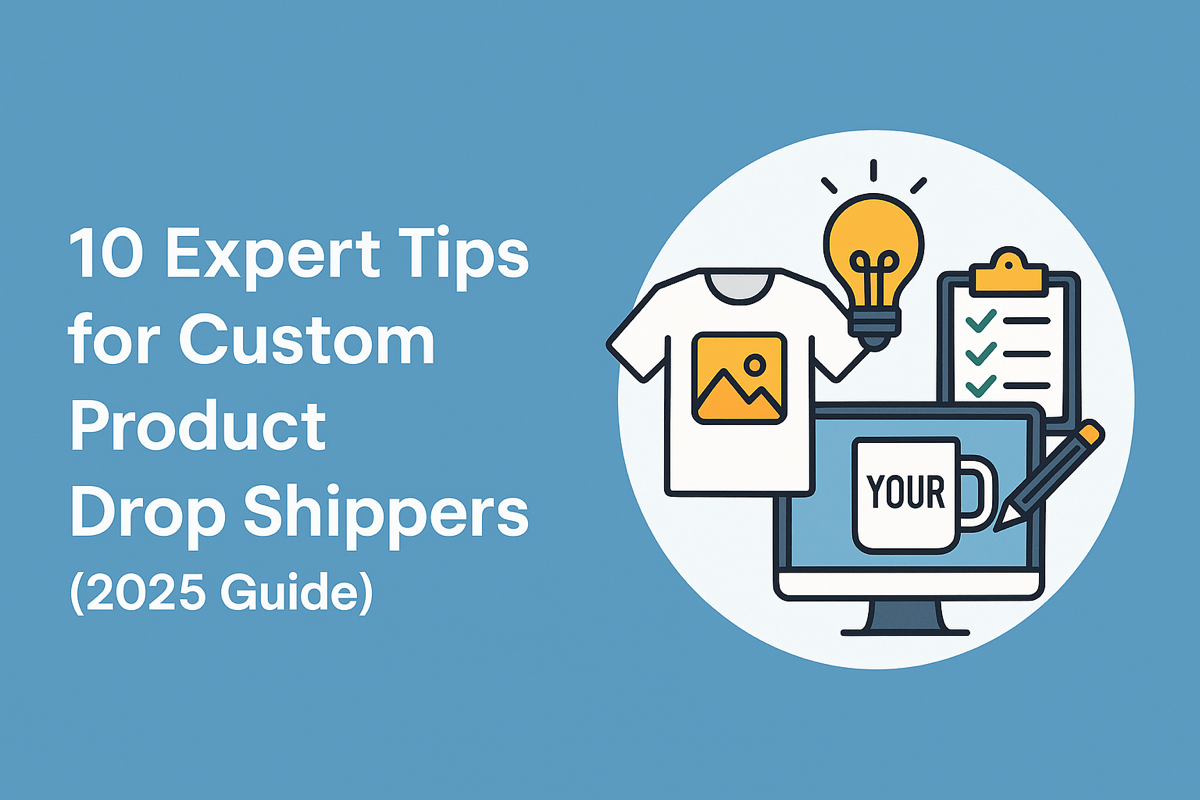
10 Expert Tips for Custom Product Drop Shippers (2025 Guide)
10 Expert Tips for Custom Product Drop Shippers (2025 Guide)
The custom product dropshipping space is booming in 2025. With consumers seeking personalized goods—from phone cases to apparel—there’s never been a better time to start or scale a custom dropshipping business. But success doesn’t come from cool designs alone. It requires smart strategies, the right tools, and a deep understanding of your customer journey.
In this guide, we’ll share 10 expert tips that can help you thrive as a custom product drop shipper. Whether you’re just getting started or looking to optimize your existing store, these strategies will give you the edge in an increasingly competitive market.
1. Pick the Right Niche for Customization
The first step to success? Choosing a niche that works well with personalization. Not every product category makes sense for customization. Focus on niches where individuality is a selling point, such as:
- Personalized phone accessories
- Custom apparel (T-shirts, hoodies, hats)
- Unique home décor
- Pet products with names/photos
- Gifts for milestones (weddings, birthdays, anniversaries)
Pro Tip: Use Google Trends and Etsy bestsellers to validate demand before committing to a niche.
2. Choose a Reliable Print-on-Demand Partner
Your production partner is your backend engine. Choose wisely. Look for:
- Fast production and shipping times
- High-quality mockup generation
- Seamless Shopify or WooCommerce integration
- Transparent pricing
- Easy product editor for end users
Top-rated partners in 2025 include Printful, CustomCat, and Gooten—but Customify also integrates with trusted POD services to give you control over your brand’s personalization experience.
3. Use High-Quality Mockups to Sell the Vision
Online shoppers can’t touch or feel your products. Your mockups are your sales pitch. Invest in:
- Studio-style product mockups with multiple angles
- Lifestyle imagery showing the product in use
- Device-responsive previews, especially for mobile
If you’re using Customify, you can auto-generate personalized previews, helping your customer see their design live before checkout—boosting both trust and conversions.
4. Optimize Your Product Pages for SEO and Conversions
Your product page is your digital storefront. Nail both SEO and CRO (Conversion Rate Optimization) by including:
- Keyword-optimized product titles and descriptions
- Fast-loading images and videos
- Customer reviews and testimonials
- Live design previews
- Clear CTAs (“Customize Now”, “Design Yours”)
Use tools like Ahrefs or Ubersuggest to research long-tail keywords like “custom dog hoodie” or “personalized iPhone 15 case.”
5. Offer Real-Time Customization
Shoppers expect a seamless design experience. With tools like Customify, you can offer:
- Drag-and-drop design editors
- Live previews of personalization
- Font, color, and layout customization
- Desktop and mobile compatibility
A smooth, intuitive customization flow reduces cart abandonment and increases engagement.
6. Test Different Product Variants and Custom Options
Don’t assume what works—test it! Run A/B tests to find the best-performing combinations of:
- Font choices
- Color swatches
- Design layouts
- Default product previews
For example, does a “minimalist” template convert better than a “bold” one? Use tools like Google Optimize or Shopify’s native A/B testing tools to experiment intelligently.
7. Streamline Fulfillment and Notifications
One of the most overlooked aspects of custom dropshipping is keeping customers informed. Set up:
- Automated order confirmation emails with design previews
- Real-time order status updates
- Integration with tracking APIs (like AfterShip)
- Clear delivery timelines on product pages
Since custom orders take longer, transparency is key to reducing refund requests and increasing customer satisfaction.
8. Build Social Proof with UGC and Reviews
Custom products make people proud. Encourage customers to share their creations by:
- Including thank-you cards with a QR code linking to a review form
- Offering a discount on their next purchase in exchange for a photo
- Showcasing user photos on product pages and social media
User-generated content (UGC) builds trust and creates a feedback loop that drives more sales.
9. Automate Customer Support for Common Questions
Questions like “How long does it take?” or “Can I edit my design after ordering?” can overwhelm your inbox. Use:
- A searchable FAQ section (Customify can help generate this)
- Chatbots with pre-loaded support scripts
- Post-purchase emails that explain what happens next
The faster your customers get answers, the more confident they’ll feel about ordering from you again.
10. Double Down on Retargeting and Email Marketing
The average customer won’t convert on their first visit. Retarget them with:
- Facebook/Instagram retargeting ads showing their saved design
- Abandoned cart emails with dynamic product previews
- Win-back sequences offering a limited-time personalization discount
Tools like Klaviyo, Mailchimp, or Omnisend integrate easily with your store and personalization platform, helping you recover sales automatically.
Final Thoughts
Custom dropshipping isn’t just about selling products—it’s about selling personal expression. By focusing on niche selection, smart tools, transparent communication, and a smooth design experience, you can build a brand that people don’t just buy from—they remember.
With platforms like Customify, offering personalized products has never been easier or more scalable. Whether you’re launching a new store or optimizing an existing one, these 10 tips will help you stand out in 2025 and beyond.